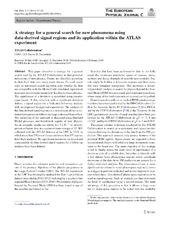A strategy for a general search for new phenomena using data-derived signal regions and its application within the ATLAS experiment
| dc.rights.license | Copyright 2019 CERN for the benefit of the ATLAS collaboration | en_US |
| dc.contributor.author | Aaboud, Morad | |
| dc.contributor.author | Aad, Georges | |
| dc.contributor.author | Abbott, Brad | |
| dc.contributor.author | Abdinov, Ovsat Bahram oglu | |
| dc.contributor.author | Abeloos, Baptiste | |
| dc.contributor.author | Abidi, Syed Haider | |
| dc.contributor.author | AbouZeid, Hass | |
| dc.contributor.author | Abraham, Nadine L. | |
| dc.contributor.author | Abramowicz, Halina | |
| dc.contributor.author | Abreu, Henso | |
| dc.contributor.author | Buanes, Trygve | |
| dc.contributor.author | Dale, Ørjan | |
| dc.contributor.author | Djuvsland, Julia Isabell | |
| dc.contributor.author | Eigen, Gerald | |
| dc.contributor.author | Fomin, Nikolai | |
| dc.contributor.author | Lipniacka, Anna | |
| dc.contributor.author | Martin dit Latour, Bertrand | |
| dc.contributor.author | Mæland, Steffen | |
| dc.contributor.author | Stugu, Bjarne | |
| dc.contributor.author | Yang, Zongchang | |
| dc.contributor.author | Zalieckas, Justas | |
| dc.contributor.author | Bugge, Magnar Kopangen | |
| dc.contributor.author | Cameron, David Gordon | |
| dc.contributor.author | Catmore, James Richard | |
| dc.contributor.author | Feigl, Simon | |
| dc.contributor.author | Franconi, Laura | |
| dc.contributor.author | Garonne, Vincent | |
| dc.contributor.author | Gramstad, Eirik | |
| dc.contributor.author | Hellesund, Simen | |
| dc.contributor.author | Morisbak, Vanja | |
| dc.contributor.author | Oppen, Henrik | |
| dc.contributor.author | Ould-Saada, Farid | |
| dc.contributor.author | Read, Alexander Lincoln | |
| dc.contributor.author | Røhne, Ole Myren | |
| dc.contributor.author | Sandaker, Heidi | |
| dc.contributor.author | Serfon, Cédric | |
| dc.contributor.author | Stapnes, Steinar | |
| dc.contributor.author | Vadla, Knut Oddvar Høie | |
| dc.contributor.author | Abulaiti, Yiming | |
| dc.contributor.author | Acharya, Bobby S. | |
| dc.contributor.author | Adachi, Shunsuke | |
| dc.contributor.author | Adamczyk, Leszek | |
| dc.contributor.author | Adelman, Jareed | |
| dc.contributor.author | Adersberger, Michael | |
| dc.contributor.author | Adye, Tim | |
| dc.contributor.author | Affolder, Anthony Allen | |
| dc.contributor.author | Afik, Yoav | |
| dc.contributor.author | Agheorghiesei, Catalin | |
| dc.contributor.author | Aguilar Saavedra, Juan Antonio | |
| dc.contributor.author | Ahmadov, Faig | |
| dc.contributor.author | ATLAS, Collaboration | |
| dc.date.accessioned | 2020-04-26T16:22:05Z | |
| dc.date.available | 2020-04-26T16:22:05Z | |
| dc.date.issued | 2019-02-06 | |
| dc.Published | Aaboud M, Aad G, Abbott B, Abdinov OBo, Abeloos B, Abidi SH, AbouZeid H, Abraham NL, Abramowicz H, Abreu H, Buanes T, Dale Ø, Djuvsland JI, Eigen G, Fomin N, Lipniacka A, Martin dit Latour B, Mæland S, Stugu B, Yang Z, Zalieckas J, Bugge MK, Cameron DG, Catmore JR, Feigl S, Franconi L, Garonne V, Gramstad E, Hellesund S, Morisbak V, Oppen H, Ould-Saada F, Read AL, Røhne OM, Sandaker H, Serfon C, Stapnes S, Vadla KOH, Abulaiti Y, Acharya BS, Adachi S, Adamczyk L, Adelman J, Adersberger M, Adye T, Affolder AA, Afik Y, Agheorghiesei C, Aguilar Saavedra JA, Ahmadov F, ATLAS C. A strategy for a general search for new phenomena using data-derived signal regions and its application within the ATLAS experiment. European Physical Journal C. 2019;79:120(2):1-45 | eng |
| dc.identifier.issn | 1434-6044 | en_US |
| dc.identifier.issn | 1434-6052 | en_US |
| dc.identifier.uri | https://hdl.handle.net/1956/22006 | |
| dc.description.abstract | This paper describes a strategy for a general search used by the ATLAS Collaboration to find potential indications of new physics. Events are classified according to their final state into many event classes. For each event class an automated search algorithm tests whether the data are compatible with the Monte Carlo simulated expectation in several distributions sensitive to the effects of new physics. The significance of a deviation is quantified using pseudo-experiments. A data selection with a significant deviation defines a signal region for a dedicated follow-up analysis with an improved background expectation. The analysis of the data-derived signal regions on a new dataset allows a statistical interpretation without the large look-elsewhere effect. The sensitivity of the approach is discussed using Standard Model processes and benchmark signals of new physics. As an example, results are shown for 3.2 fb−1 of proton–proton collision data at a centre-of-mass energy of 13 TeV collected with the ATLAS detector at the LHC in 2015, in which more than 700 event classes and more than 105 regions have been analysed. No significant deviations are found and consequently no data-derived signal regions for a follow-up analysis have been defined. | en_US |
| dc.language.iso | eng | eng |
| dc.publisher | Springer Nature | en_US |
| dc.rights | Attribution CC BY | eng |
| dc.rights.uri | http://creativecommons.org/licenses/by/4.0/ | eng |
| dc.title | A strategy for a general search for new phenomena using data-derived signal regions and its application within the ATLAS experiment | en_US |
| dc.type | Peer reviewed | |
| dc.type | Journal article | |
| dc.date.updated | 2019-11-22T12:24:20Z | |
| dc.description.version | publishedVersion | en_US |
| dc.identifier.doi | https://doi.org/10.1140/epjc/s10052-019-6540-y | |
| dc.identifier.cristin | 1705204 | |
| dc.source.journal | European Physical Journal C | |
| dc.subject.nsi | VDP::Matematikk og naturvitenskap: 400::Fysikk: 430::Kjerne- og elementærpartikkelfysikk: 431 | |
| dc.subject.nsi | VDP::Mathematics and natural scienses: 400::Physics: 430::Nuclear and elementary particle physics: 431 |

